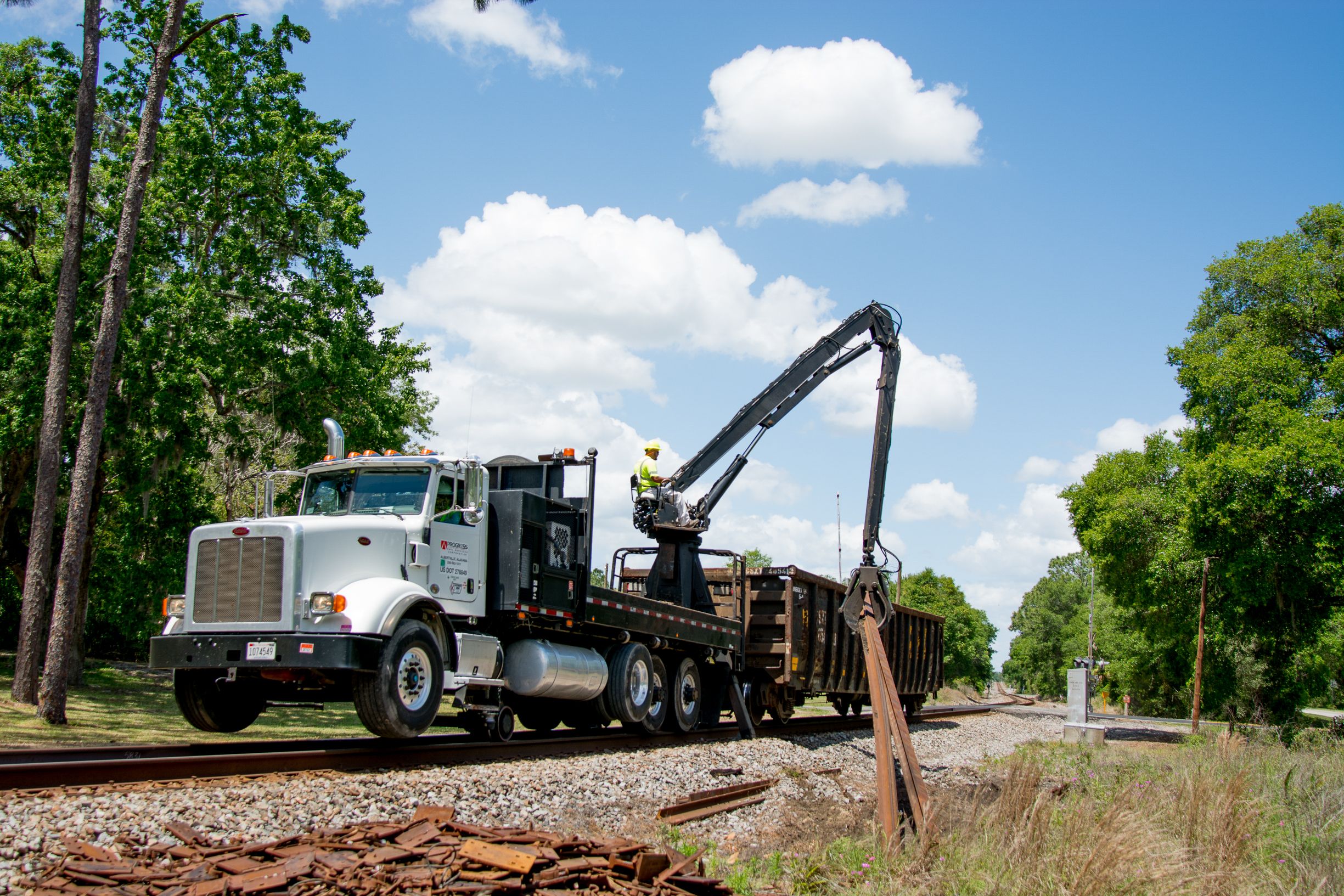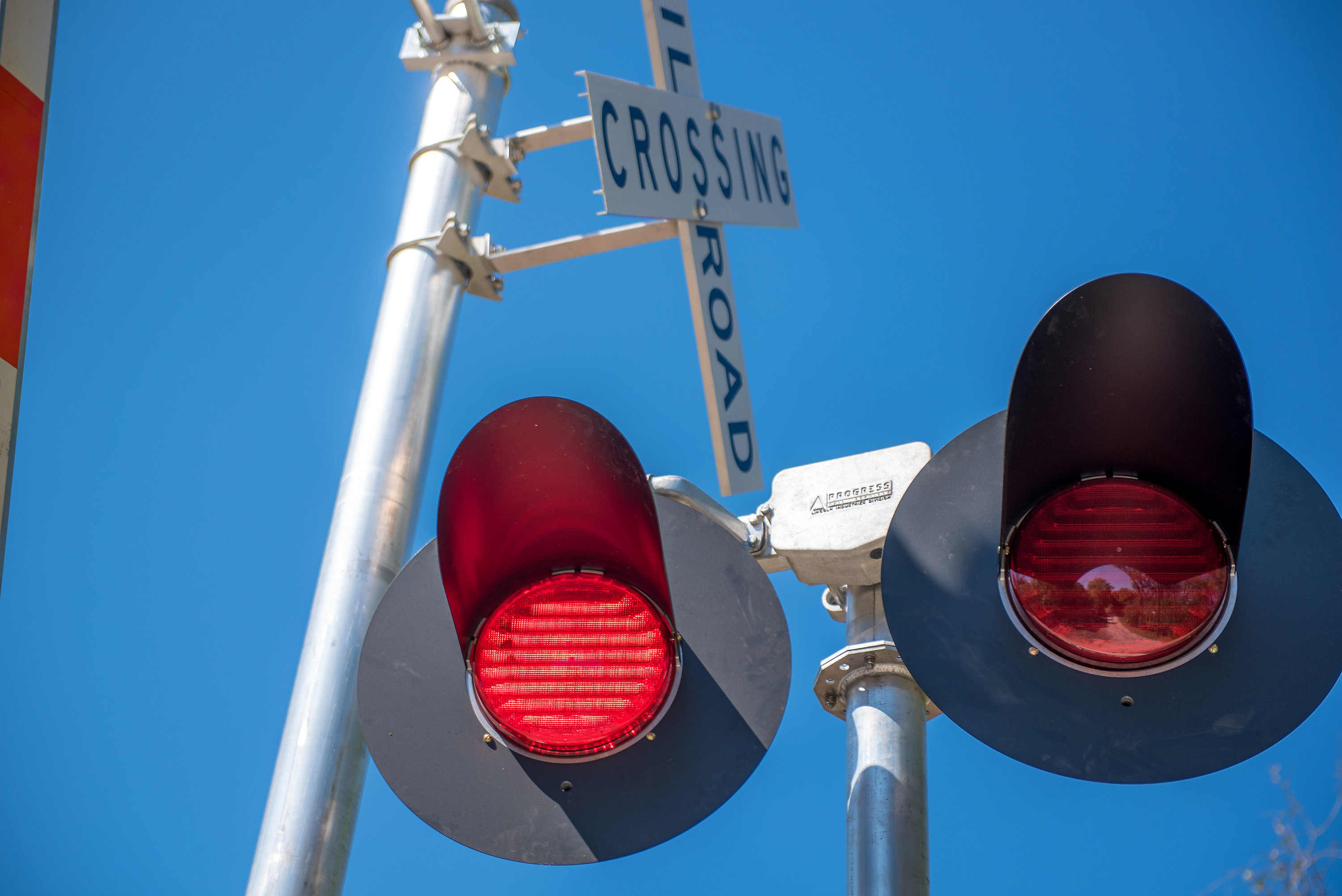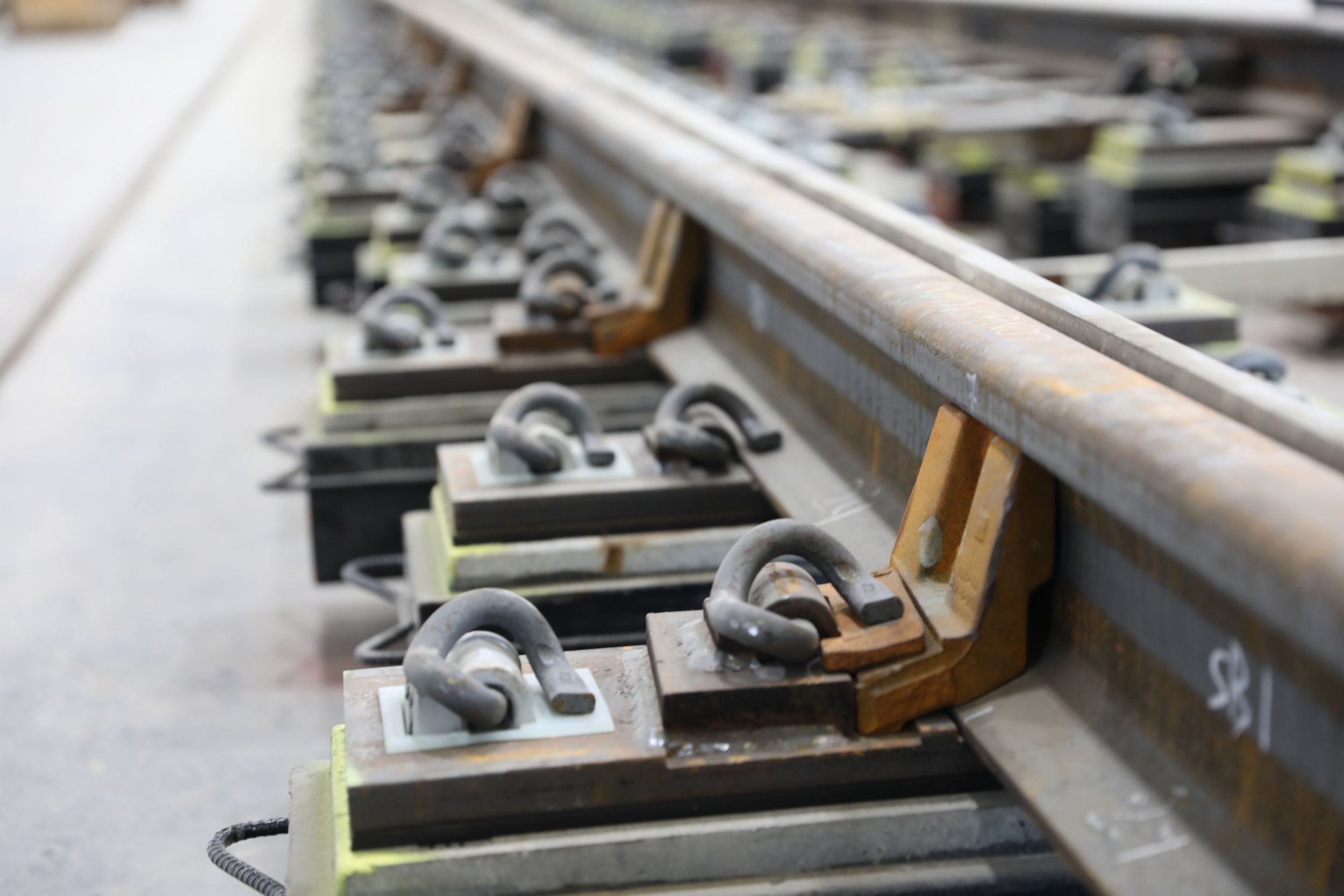These pre-operation views of installed Eggs for Guard and Restraining Rail show their similarity to the standard Egg. The obvious difference is the fact it is bigger and has an increased rail seat dimension to accommodate the guard rail assembly. Vertical stiffness is comparable to that of the standard Egg.
The Egg for Guard and Restraining Rails is in many ways the same as the Egg track fastener for standard track. The obvious difference, of course, is the fact it is bigger and has increased rail seat dimension to accommodate the guard rail assembly.
It will have comparable vertical stiffness.
Essential differences include:
Please note that guard rail block design includes two 1/4” shims. It is recommended to retain this design because there are standard insulators that fill the void created when one or both shims are removed to compensate for expected head wear of the guard/restraining rail.
The Egg fastener is specifically designed to reduce ground-borne vibration, the cause of secondary noise in buildings neighboring transit tracks. The Guard/Restraining Rail Egg contains many of the characteristics and advantages of the standard Egg for normal track.
Egg fasteners consist of two metal components - the Top Plate and containment Frame - bonded together with elastomer. Ductile iron was selected for all metal components because of its strength, endurance, corrosion resistance and economics. Rubber is the elastomer of choice, with corrosion resistance and economics. Rubber is the elastomer of choice, with rare exception, due to its superior spring performance and enduring lifetime characteristics (I.e., dynamic stiffness).
The Guard or Restraining Rail assembly rests on the Top Plate. Its side surface is angled with respect to the vertical. There is a corresponding angled surface built into the outer containment Frame that supports and also houses the anchor bolt holes. The Top Plate is suspended on a belt of elastomer, bonding it to the mating angled surface of the Frame. This allows the Top Plate to “float” and geometry dictates that vertical forces be transmitted largely in shear and only partially in compression. This is perhaps the single most significant feature explaining the unique acoustical effectiveness of the Egg-type design.
Equally important, the geometry also provides “fail-safe” maintenance of track gauge. Thus, the Egg-type design creates the vital combination of lateral integrity and vertical softness. Reacting to overload, or the unlikely event of elastomer failure, the Top Plate sinks further and further into the “nest” provided by the Frame. As it does, lateral stability is not only maintained, but is increased - a huge safety benefit, particularly on curves.
DIMENSIONS
Body Length 23”
Body Width 10”
Width Across Anchor Bolt flanges 12”
Rail Seat Elevation 2 3/4” (70mm)
Rail Base Width 10 1/2” (115# RE Rail)
WEIGHT
Body only 70 lbs
Gage adjustment clip 0.5 lbs
Pandrol “e” clip 1.7 lbs
Metal Parts Top Plate, Containment Frame and Gage Adjustment Clip are all ASTM 536, Grade 65-45-12 Ductile Iron Castings
Elastomer Natural Rubber
Assembly Metal parts fully bonded together with elastomer
Anchor Bolts 1” diameter bolts or studs meeting or exceeding ASTM A-325. Use lock washers in either case. If stud, nut should also meet or exceed A-325
Rail Clips Pandora “e”-2055 clips and "e"-2061 clips
The Egg for Turnouts contains many of the same advantages and characteristics of the standard Egg for normal track.
Egg fasteners consist of two metal components - the Top Plate and containment Frame - bonded together with elastomer. Ductile iron was selected for all metal components because of its strength, endurance, corrosion resistance and economics. Rubber is the elastomer of choice, with corrosion resistance and economics. Rubber is the elastomer of choice, with rare exception, due to its superior spring performance and enduring lifetime characteristics (I.e., dynamic stiffness).
The rails or turnout components rest on the Top Plate. Its side surface is angled with respect to the vertical. There is a corresponding angled surface built into the outer containment Frame that supports and also houses the anchor bolt holes. The Top Plate is suspended on a belt of elastomer, bonding it to the mating angled surface of the Frame. This allows the Top Plate to “float” and geometry dictates that vertical forces be transmitted largely in shear and only partially in compression. This is perhaps the single most significant feature explaining the unique acoustical effectiveness of the Egg-type design.
Equally important, the geometry also provides “fail-safe” maintenance of track gauge. Thus, the Egg-type design creates the vital combination of lateral integrity and vertical softness. Reacting to overload, or the unlikely event of elastomer failure, the Top Plate sinks further and further into the “nest” provided by the Frame. As it does, lateral stability is not only maintained, but is increased - a huge safety benefit, particularly on curves.
The belt of elastomer separating the two metal components not only dampens rail forces, but also provides excellent electrical isolation.
Vertical static stiffness are comparable to the Egg for normal track - in the range of 50,000 and 75,000 pounds per inch. These values are approximate - contact us for more details.
Because of the constantly changing geometry of turnout rails, it is impractical to produce individual Eggs for specific locations. Instead, Turnout Eggs contain a standard pocket in their Top Plate. The turnout manufacturer will supply these plates (according to ATP specifications and drawings) with their special trackwork. Aside from drawings, we can also provide the turnout manufacturer with live samples to confirm and otherwise improve their understanding of the need.
Up to now, the sizes we offer (Type I, II and III) have readily suited the turnouts typically used in transit service. However, if the need arises, we already have designs for larger units (Types IV, V, etc.).
The Frame is supplied with four anchor bolt locations, two on each side of the rail. Openings for anchor bolts are not slotted, therefore do not permit gage adjustment. If this becomes an issue, the design can be altered to include this feature.
Locating anchor bolts at the perimeter of the Frame yields important advantages:
Fasteners are usually mounted directly on the concrete invert, however, if elevation between adjacent fasteners exceeds 1/16”, metal or appropriate plastic shims should be installed which must provide bearing surface under the full fastener “foot-print”.
DIMENSIONS & WEIGHT
| Type I | Type II | Type III | |
|---|---|---|---|
| Body length | 759mm | 929mm | 1270mm |
| Body width | 395mm | 395mm | 395mm |
| Rail seat | 70mm | 70mm | 70mm |
| "Pocket" length | 588mm | 730mm | 1080mm |
| "Pocket" width | 127mm | 127mm | 127mm |
| Weight (fastener only) | 45kg | 59kg | 90kg |
Metal Parts Top Plate, Containment Frame are Ductile Iron Castings
Elastomer Natural Rubber
Assembly Metal parts fully bonded together with elastomer
Anchor Bolts 1” diameter bolts or studs meeting or exceeding SAE J429 Grade 5. Use lock washers in either case.
Miscellaneous
Progress Rail’s trackwork experience and remanufacturing capabilities enable us to provide quality trackwork to your specifications. Whether you need new rail, recycled rail, Other Track Material (OTM), complete turnout packages or a single trackwork component, our facilities can fulfill your requirements.
Learn MoreProgress Rail has long been a signaling provider, designing wayside and highway crossing systems for railroads since 1992. Our signal engineering and asset protection are just some of the many ways we can help your business.
Learn MoreProgress Rail offers a full line of trackwork, components and fasteners for heavy haul and transit railways, and is a leading manufacturer of specialty trackwork in North America, the United Kingdom and Australia. With state-of-the-art manufacturing facilities located strategically around the globe, we produce the highest quality trackwork and fasteners, with 100-plus years of experience in the design and manufacture of cast manganese crossings.
Learn More









